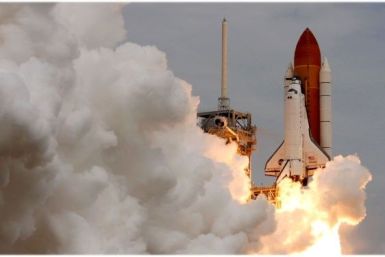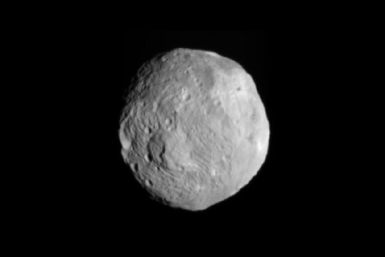A piece of space shuttle Columbia, which was disintegrated on re-entry over the Texas state on February 1, 2003, has emerged as the Texas lake dried up because of drought.
A piece of the space shuttle Columbia, which broke into pieces over the Texas skies on February 1, 2003, has been found in a Texas lake after a drought caused the waters to recede.
A NASA satellite caught a stunning video of an enormous plasma twister rising from the sun's surface on July 12.
Official confirmation has come from NASA that debris revealed by prolonged drought in Texas belongs to the Space Shuttle Columbia.
The molecules were detected in the star-forming region of the Orion constellation. The amount of oxygen found is ten times larger than what was indicated by previous observations of other molecular clouds, but is still well below theoretical expectations, according to ESA.
The Herschel Space Observatory has detected the first ever oxygen molecules in space, located in the Orion nebula, which ended a mystery lasting 230 years regarding oxygen in space.
Americans are not happy NASA is not ending the space shuttle program.
The founder of Space Exploration Technologies Corp. (SpaceX) would like to see humans set up a colony on Mars in the next few decades.
More debris from a spacecraft that broke up while re-entering Earth's atmosphere eight years ago has been discovered. On February 1, 2003, space shuttle Columbia scattered debris in the East Texas city of Nacogdoches.
The first close-up pictures of the asteroid Vesta, a protoplanet that dates back to the early days of the solar system, revealed a surprisingly diverse terrain and several unexplained geologic features, NASA scientists said on Monday.
NASA's Dawn spacecraft gets a clear image of the Vesta asteroid.
NASA's Dawn mission spacecraft will descend to a 1,700-mile-high orbit on Aug. 11 where scientist will begin an examination of the Vesta asteroid, the second-largest in the main asteroid belt.
Turning a new page in her post-shooting life, U.S. Congresswoman Gabrielle Giffords attended Congress last night to take part in the voting on the debt deal.
NASA's Dawn spacecraft, the first ever to orbit an object in the main asteroid belt, has provided striking latest images of the asteroid Vesta, the second-most largest in the asteroid belt.
Space Exploration Technologies, a privately owned firm developing a space taxi with U.S.-government backing, plans to launch its second test capsule on November 30 and send it all the way to the International Space Station, a company manager said on Thursday.
The Vesta is the second-largest asteroid in the main asteroid belt, which is located between Mars and Jupiter.
NASA's Dawn spacecraft slipped into the asteroid's orbit last month and already beamed hundreds of images for scientists to begin poring over. NASA has taken images over the Vesta's northern Hemisphere after the spacecraft finished its first passage over the dark side of the giant asteroid.
Private spaceflight firm Space Exploration Technologies, SpaceX, which is preparing to send a space capsule to the International Space Station this November, will team up with NASA to send a mission to search for life on Mars.
NASA, which has sent men to the moon and space for decades, may have to shelve its ambitious plans of sending astronauts to further reaches of space beyond the moon - it faces nearly $1 billion in cleanup costs for the deep chemical messes it has left behind at Kennedy Space Center and other launch centers.
Russian cosmonauts will undertake a spacewalk leaving the International Space Station on Wednesday to move a cargo boom from one airlock to another, install a prototype laser communications system and deploy Ham Radio's amateur micro-satellite.
Space Exploration Technologies, or simply SpaceX, and other private sector companies are vying to fill the void for transport to space after the U.S. government put the breaks on its own shuttle program.
One of the biggest questions that scientists usually face is why the sun's corona is so hot. Well, thanks to a new research, it seems that scientists are now one step closer to unearth the mystery.





































